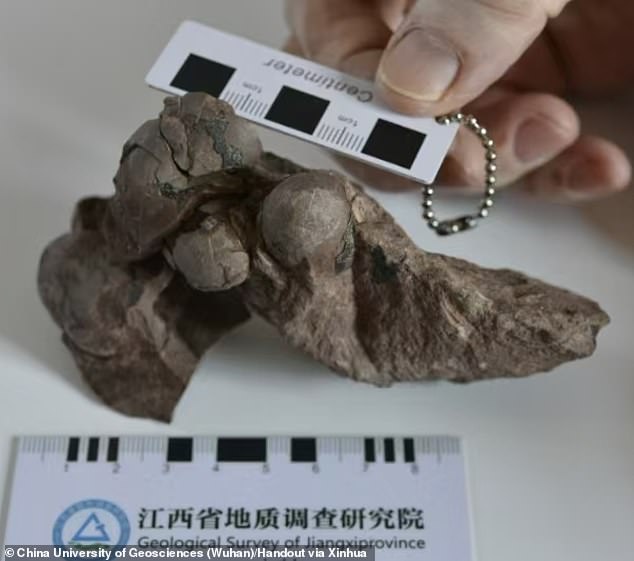Scientists discover 80-million-year-old ‘fully intact’ dinosaur eggs from previously unknown species
The smallest fully intact dinosaur egg ever discovered has been unearthed in a remote area of China.
The egg, which is just over an inch long, was one of six dinosaur eggs found in a completely preserved Late Cretaceous nest.
The small size of the eggs, the irregular arrangement of the eggs, the worm-like and nodular ornamentations and the thickness of the shell meant that they were unlike any other known predatory dinosaurs.
This fossil marks an important discovery that could shed light on the reproductive habits and diversity of dinosaurs.
Researchers from China University of Geosciences recovered six dinosaur eggs in 2021 from a construction site in Ganzhou, known as one of the “richest egg fossil sites in the world.”
The team studied the fossils for three years before confirming that they were dinosaur eggs and determined that they belonged to a new species called Minioolithus ganzhouensis.
Researchers plan to conduct more studies that they hope will shed light on the type of dinosaur the egg came from and what the species looked like.
Researchers in China discovered a rare fossil of dinosaur eggs from 80 million years ago, the smallest ever recovered. At just 3.5 cm long, the egg belongs to a new dinosaur species that could help paleontologists understand their reproductive habits and species diversity
Researchers reported discovering the new egg at a construction site in Meilin, a town on the outskirts of Ganzhou city.
According to Han Fenglu, associate professor of vertebrate paleontology at CUG, a rare, well-preserved nest of six eggs was found at the site.
Fenglu reported that the eggs came from small theropods – a class of carnivorous and predatory dinosaurs that also includes the well-known Tyrannosaurus Rex.
Their findings were published last week in the journal Historical Biology.
The team used scanning electron microscopy (SEM) and electron backscatter diffraction to analyze the shape and type of decoration of the shell.
This type of scanning technique works by focusing an electron beam to examine the surface material of an object and generating high-resolution images.
Election backscatter diffraction then scans the SEM findings and analyzes the texture and structure of the material to discern patterns in the shell.
The technology revealed that the fossil’s size, thickness, pore system and ultrastructure were significantly different from other previously discovered egg fossils.

The egg belongs to a family of oval-shaped dinosaur eggs that are part of small therapods. This is a type of predatory dinosaur including the Tyrannosaurus Rex
Their findings allowed the researchers to classify the fossils as part of the elliptical family of oval-shaped dinosaur eggs.
More research needs to be done to discover how the Minioolithus ganzhouensis species evolved millions of years ago and its reproductive strategies.
The next phase of the research aims to gain “deeper insights into the lives and ecology of these ancient creatures,” according to the Global times.
The fossil, called the Ganzhou mini egg, shattered the previous record holder for the smallest egg, which was 1.5 inches long.
Paleontologists from CUG, the Institute of Vertebrate Paleontology and Paleoanthropology of the Chinese Academy of Sciences, plan to conduct further research on the Ganzhou mini egg using micro-CT scanning that uses X-rays to create a three-dimensional to create a model of the egg’s internal structure.
They hope this process will help them better understand how the eggs were formed and determine the exact type of dinosaur that laid them.
It could also reveal new aspects of dinosaur biology and the environmental conditions the species experienced during the Late Cretaceous.
This is what the researchers say in the study: ‘This discovery increases the diversity of dinosaur eggs in the Late Cretaceous and is important for our understanding of Late Cretaceous theropod evolution.’
